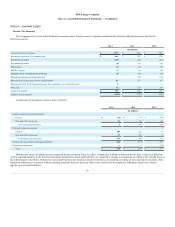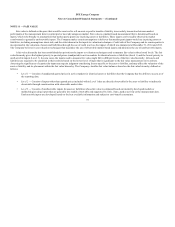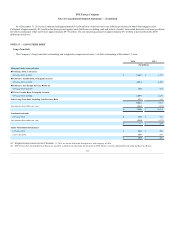DTE Energy 2014 Annual Report Download - page 82
Download and view the complete annual report
Please find page 82 of the 2014 DTE Energy annual report below. You can navigate through the pages in the report by either clicking on the pages listed below, or by using the keyword search tool below to find specific information within the annual report.
The Company’s primary market risk exposure is associated with commodity prices, credit and interest rates. The Company has risk management
policies to monitor and manage market risks. The Company uses derivative instruments to manage some of the exposure. The Company uses derivative
instruments for trading purposes in its Energy Trading segment. Contracts classified as derivative instruments include electricity, natural gas, oil and certain
coal forwards, futures, options and swaps, and foreign currency exchange contracts. Items not classified as derivatives include natural gas inventory, pipeline
transportation contracts, renewable energy credits and natural gas storage assets.
DTE Electric — DTE Electric generates, purchases, distributes and sells electricity. DTE Electric uses forward energy contracts to manage changes in
the price of electricity and fuel. Substantially all of these contracts meet the normal purchases and sales exemption and are therefore accounted for under the
accrual method. Other derivative contracts are MTM and recoverable through the PSCR mechanism when settled. This results in the deferral of unrealized
gains and losses as Regulatory assets or liabilities until realized.
DTE Gas — DTE Gas purchases, stores, transports, distributes and sells natural gas and sells storage and transportation capacity. DTE Gas has fixed-
priced contracts for portions of its expected natural gas supply requirements through March 2017. Substantially all of these contracts meet the normal
purchases and sales exemption and are therefore accounted for under the accrual method. DTE Gas may also sell forward transportation and storage capacity
contracts. Forward transportation and storage contracts are generally not derivatives and are therefore accounted for under the accrual method.
Gas Storage and Pipelines — This segment is primarily engaged in services related to the transportation and storage of natural gas. Primarily fixed-
priced contracts are used in the marketing and management of transportation and storage services. Generally these contracts are not derivatives and are
therefore accounted for under the accrual method.
Power and Industrial Projects — This segment manages and operates energy and pulverized coal projects, coke batteries, reduced emissions fuel
projects, landfill gas recovery and power generation assets. Primarily fixed-price contracts are used in the marketing and management of the segment assets.
These contracts are generally not derivatives and are therefore accounted for under the accrual method.
Energy Trading — Commodity Price Risk — Energy Trading markets and trades electricity, natural gas physical products and energy financial
instruments, and provides energy and asset management services utilizing energy commodity derivative instruments. Forwards, futures, options and swap
agreements are used to manage exposure to the risk of market price and volume fluctuations in its operations. These derivatives are accounted for by
recording changes in fair value to earnings unless hedge accounting criteria are met.
Energy Trading — Foreign Currency Exchange Risk — Energy Trading has foreign currency exchange forward contracts to economically hedge fixed
Canadian dollar commitments existing under natural gas and power purchase and sale contracts and natural gas transportation contracts. The Company enters
into these contracts to mitigate price volatility with respect to fluctuations of the Canadian dollar relative to the U.S. dollar. These derivatives are accounted
for by recording changes in fair value to earnings unless hedge accounting criteria are met.
Corporate and Other — Interest Rate Risk — The Company uses interest rate swaps, treasury locks and other derivatives to hedge the risk associated
with interest rate market volatility.
Credit Risk — The utility and non-utility businesses are exposed to credit risk if customers or counterparties do not comply with their contractual
obligations. The Company maintains credit policies that significantly minimize overall credit risk. These policies include an evaluation of potential
customers’ and counterparties’ financial condition, credit rating, collateral requirements or other credit enhancements such as letters of credit or guarantees.
The Company generally uses standardized agreements that allow the netting of positive and negative transactions associated with a single counterparty. The
Company maintains a provision for credit losses based on factors surrounding the credit risk of its customers, historical trends, and other information. Based
on the Company’s credit policies and its December 31, 2014 and 2013 provision for credit losses, the Company’s exposure to counterparty nonperformance
is not expected to have a material adverse effect on the Company’s financial statements.
79
























